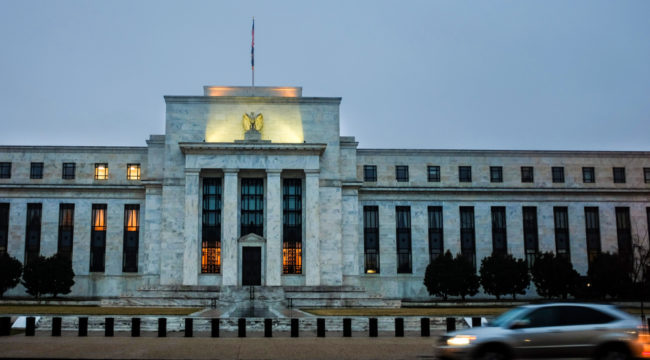The Fed Has "Returned the Punch Bowl"
The Federal Reserve has essentially “returned the punch bowl,” says one analyst… and is “encouraging everybody to have a drink.”
Barman Jerome Powell set the bowl down yesterday afternoon at 2:00 Eastern. And rang the bell.
The market had a swig, then another — and gagged on the swill.
The Dow Jones crossed briefly into green after the Federal Reserve’s nonrate hike.
But it soon returned to its sober senses. Some 150 points it gave back by the closing whistle.
Nearly a decade running, bad news for the economy equated good news for the stock market.
The Federal Reserve would cut rates or let loose another round of quantitative easing… and a rainbow would form in the skies over Wall Street.
But not yesterday.
The announcement itself was expected. Less expected was the extended forecast…
Mr. Powell and his mates projected no rate hikes at all this year. They further announced the end of quantitative tightening (QT) by September.
As recently as December they penciled in two 2019 rate increases… and a hawkish Mr. Powell claimed QT was running “on autopilot.”
But his announcement sent the stock market crashing earthward. So Powell disengaged the autopilot… and pulled back on the stick.
Previously a hawk, he flew into 2019 a dove.
Wall Street turned him from war hawk to bird of peace.
“Normalization,” we hardly knew ye.
If the Federal Reserve cannot raise interest rates above 2.50% and reduce its balance sheet to under $4 trillion… can it ever return to normal?
But following yesterday’s initial spasm, perhaps stocks deciphered the message of weakness Mr. Powell was telegraphing.
Explains Ian Lyngen, head of U.S. rates strategy at BMO Capital Markets:
This decision falls firmly on the dovish side… as the about-face from “further gradual tightening” has now reached a complete 180 degrees.
Or as Art Hogan, chief market strategist at National Securities styles it:
Hey, great, the ambulance got here — oh, wait, we need an ambulance. The Fed to the rescue — oh, wait, we need the Fed to rescue us?
But the sirens are wailing…
As we have chronicled endlessly, the economic patient is slipping, its vitals fading.
GDP growth is trending wrong, the American consumer groans under record debt, the global economy teeters.
One example sharply in point:
FedEx stock dropped 3.5% yesterday after it slashed its 2019 profit forecast. Slowing global trade was the reason it cited.
And the Dow Jones transportation average — a reliable thermometer of economic health — slipped 1.3% on the day.
Meantime, the unemployment rate sank to a 3.7% low in September. It is unlikely to sink to such depths in the current cycle.
And data from the National Bureau of Economic Research indicates recession is often on tap nine months after unemployment bottoms.
We have even detected the Federal Reserve itself dropping subtle hints of coming recession… like a pitcher tipping his pitches.
The San Francisco outpost of the Federal Reserve recently published a paper on the virtues of negative interest rates — “How Much Could Negative Rates Have Helped the Recovery?”
Answering its own question:
The Federal Reserve dropped the federal funds rate to near zero during the Great Recession to bolster the U.S. economy. Allowing the federal funds rate to drop below zero may have reduced the depth of the recession and enabled the economy to return more quickly to its full potential. It also may have allowed inflation to rise faster toward the Fed’s 2% target. In other words, negative interest rates may be a useful tool to promote the Fed’s dual mandate.
The head of the same San Francisco branch also suggests QE might become a permanent instrument of policy:
An important question is should those [tools like QE] always be in the tool kit? Should you always have them at your ready, or should you think about [how] those are only tools you use when you really hit the zero lower bound and you have no other things you can do?
Why now?
Would they be pounding a drum for negative interest rates and QE forevermore… for no particular reason?
We wonder.
So does analyst Sven Henrich. Concerning yesterday’s announcement:
Let’s be very clear what Wednesday’s full-frontal capitulation by the Fed means: It’s coming. The next recession, that is. It’s just a matter of the how and the when…
The Fed will never, ever overtly tell you a recession is coming. They can’t. Their underlying primary mission is to keep confidence up. A Fed predicting a recession would cause all kinds of havoc in capital markets and almost certainly bring about a recession. So they won’t tell you, but their actions speak loud and clear.
Is Wall Street finally listening?
Regards,
Brian Maher
Managing editor, The Daily Reckoning



Comments: